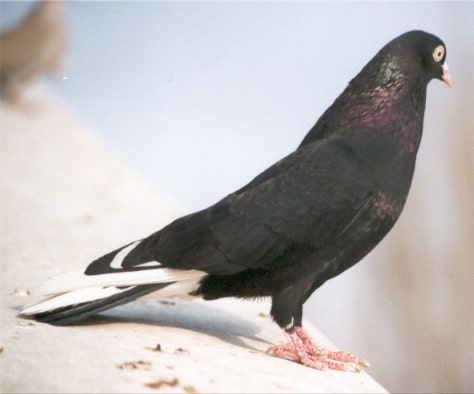
BURSA
This breed, named after the city of Bursa, located in the Marmara region of Turkey, is predominantly raised in this city and the surrounding towns. Even though they are known as Bursa outside of this region throughout Turkey, they are known to the locals as "Oynar" (player) and "Akkanat" (white-wing). In Thrace region and the city of Edirne it is called "Kesme" (cutter). Around the world they are know with such names as "Bursa roller", "Bursa Tümmler" and "Rouleur de Bursa".
This breed is mainly raised in downtown Bursa. They are also well spread in the town of İnegöl. Even though, the fanciers in İnegöl claim the origin of this breed, this is not a fact. Migration of Bursa to İnegöl was accomplished by the old fanciers known as the İnegöl's Selo and the glassmaker. Besides Bursa and İnegöl, this breed also exists in Mustafakemalpaşa, Eskişehir, Afyon and İstanbul. We can't say it is a popular breed throughout the country, but it is mostly in the Marmara, Aegean regions and to some degree in the Thrace.
HISTORY OF THE BREED
It is a known and accepted knowledge by fanciers, that the origin of Bursa is rather old and dates back to the Ottomans. While we do not have any clear document in our hands, it is known that their past goes back to the fall of Bursa to Ottomans and its establishment as the first continuous capital of the empire 1335. It is said that they were brought to Bursa by Kara Timurtaş Pasha, who became a vizier after fighting many battles and achieving high level of successes.
This information is based on the knowledge of old fanciers. The documented facts are that Kara Timurtaş Pasha's raise to vizier status in 1387, during the rule of Padishah (sultan) Murat I. (1362-1389) and participated in many battles during Murat's time in mainly Balkans and Rumelia (name for the part of Ottoman Empire in Europe). He had attended the Bosnia and Albania campaigns, and present in the famous 1st Kosova war (1389). One could guess that he had brought these birds during one of these campaigns. One thing is for sure the Bursa breed has been accounted for 600 years in Turkey.
TODAY'S FANCIERS OF BURSA
It is a known fact that many families in Bursa have passed their birds from fathers to sons over decades. Today the number of fanciers that continue 50-60 years old bloodlines have declined a great deal. It is said that today there are only two fanciers who keep the original form of Bursa in the city. One of these people is İsmail Bey. During my trip to Bursa, I had an opportunity to see and meet with him. These families really protect their bloodlines impressively. In fact, they continue to keep their birds without selling to anyone, without bringing any other bloodlines in and in fact they don't even show their birds to anyone.
Unfortunately, as the price of this secrecy, they also do not fly their birds. They are not willing to take the risk of losing the bloodline by flying the birds. For these fanciers selling, buying or money has no value. Regardless of the offer of the amount of money it is not possible for one to purchase a bird from them. During my visit to Ismail Bey, I learned many new information on the breed. To be frank, when he wanted to give me a pair of his birds as a gift, I felt full of emotions. Most of the old fanciers do not even want to give information on their birds. When they make comments like these birds are half breed or they are junk about the birds out in the city, they do not give any answer to the question of "so, what is the original bird supposed to be like?" Old fanciers state that the birds of today are the product of last 40 years and has been degenerated.
Hasan Güler, who says he has stopped keeping birds since the Bursa breed has lost all of its original qualities, describes the breeds qualities in his own words; birds that stand out for us, besides the ones called "koca zikirli" the type kept generally in Bursa, "cicili" I mean, like the ones you saw in İsmail Bey's coop and the ones the fanciers of İnegöl claim to be their own. Ones called zikirli are white winged and white tailed. The section of the head where it connects to the beak is concaved and the nose should be rather puffed up. There is a zikir marking at the tip of the beak. I swear to God, when you look into their eyes, you will see around the pupil of the eye it will be glossy and resembles dried rose pedals.
Looking into your eyes, they will narrow their eyes. Eye lids must be pure white. Forehead bulging out won’t be considered to be a fault, but the head has to be round shaped. When the chest is held towards the back it has to be slim like a ballerina. Feathers have to slide in your hands like an exquisite velvet cloth. I am not sure, if it is easy to not to be affected by these descriptions. Old fanciers, talking about the old bloodlines of Bursa in this way, naturally do not like today's Bursas and consider them to be crossed or mutts. In my opinion, the difficulty of setting the standards for Bursa comes from here. This is the origin of all those arguments and disagreements over the breed.
For example, when the old fanciers do not care about the wing or tail miss-coloration in the form of a black or white feather showing up out of order or the forehead slightly sticking out, younger fanciers not being familiar of the old standards bring forward other qualities. Characteristics of the breed I am about to say are based on today's expectations.
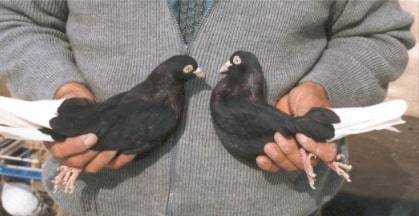
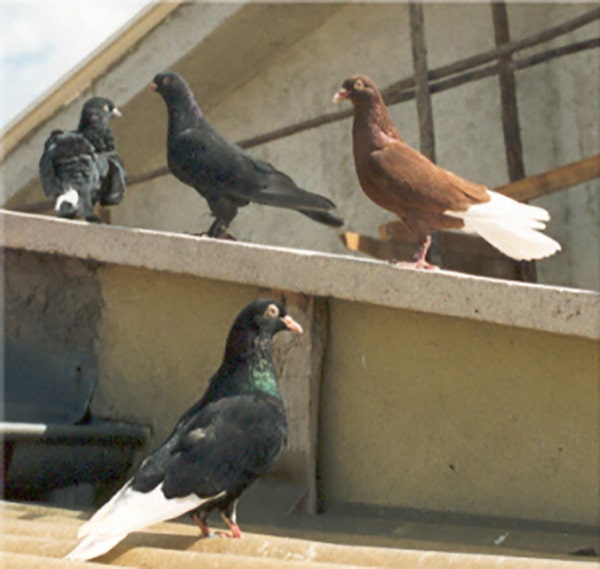
FLIGHT CHARACTERISTICS OF BURSA
Bursa's flight style is extremely fast and rapid. They possess a very agile flight maneuverability. The moment before the flight they tend to look agitated. In the air they fly with thrusting wing movements. They open their wings halfway and use rapid wing strokes. Wings do not extend to a large degree during flight, only when they are in a position like rowing arm, the angle increases and at times it creates a whipping sound. They have rather hard wing strokes. They are flown in groups to bring out their flight qualities. Kit must be made out of at least 8 birds and can be 20 or more. Even though, they follow each other during the flight they have an individual flight style. A loose kit is a desired quality.
Birds that fly in tight kits are considered to be faulty. They fly very high, almost disappearing from eyesight. They do not need to be escorted by another breed. Bursa is an endurance flier. In average they fly 3 to 4 hours and some around 7 to 8 hours. Of course, this is closely related to the training they receive and their bloodlines. To achieve a good level of performance they must be flown starting very early age and continue to get a strict flight training. It takes about a year for their classic flight style to show up. Flying for long hours is a desired quality in Bursa. Simply, birds are valued as much as they fly.
During flight, Bursa do not respond to droppers, whistles or flags like other breeds. Because of this, it is not possible to control the birds once they get airborne. Therefore, Bursas cannot be lured to other lofts. After flight they will only land on their loft. During flight they do not pay attention to other kits flying close by. Landing is rather simple for Bursas. After passing by above the loft a few times they land with a small but rapid dive. Because of this quality they can also be raised in balconies of apartments.Most characteristic flight quality of Bursa is rolling. Rolling bird separates from the kit and falls. In average they perform 10 rolls per fall and drop about 30 meters. After this, the bird fly back up to the kit. Once a member of the kit rolls the rest also fallow it with rolls and this is a rather nice sight to see. Maybe because of this the old fanciers say "Oynarın hası kalpten siler pası" (real Bursa will restart your heart).
Besides rolling Bursas also perform sudden 45 degree dives every so often. During the dive they flap their wings rather fast and then climb up to the kit with same fashion. This is a desired quality of the breed. This dive and their hard and rapid flight style make them hawk proof. However, their long and high flight makes them vulnerable to some degree at the end of their flight. Some breeders do not consider the rolling abilities of this breed. They look for long flight rather than long rolls and dives. I can't say I share their opinions.
THE DANGERS WAITING BURSA
In my opinion, there are two general mistakes take place in performance breeds in Turkey. Either, the performance takes to fore place and color and shape becomes not important or the color and shape becomes more important and the performance is just not considered by fanciers. I think they are both wrong. In performance breeds even though the performance is the most important the color and shape should also be maintained.
It is very clear that Bursa is a performance breed. However, last few years, many fanciers have been looking at them as show breeds. This has been causing the flight and performance qualities to decline. Their long flight time has been getting shorter and shorter. This is also true for their rolling abilities. Rolling ability is in their genes and what makes Bursa what it is. I think, as breeders we do not have a right to destroy this or not recognize its existence. I think, a good Bursa is a good roller. There cannot be any reasonable explanation for trying to erase this quality out of them.
Today, some of the older fanciers raise their birds in captivity without flying them. Being afraid of them getting stolen or falling into hands of others cannot be reasons to not to fly these birds. As soon as we stop flying our birds, without even thinking about it, the show qualities become more important. When the physical qualities of a performance breed become more important than anything else, this signals the end of the breed. Biggest danger the Bursa faces today is that.
Moreover, nowadays Bursa has been subject to crossbreeding with roller breeds from the Balkans. Bulgaria originated Filibe and the Trace have been used in these so-called improvement projects and to some degree contributed to erosion of the qualities of the breed. These efforts, that in my opinion arise from the goal of introducing head crest to Bursa, are natural results of the move towards the show breeding.
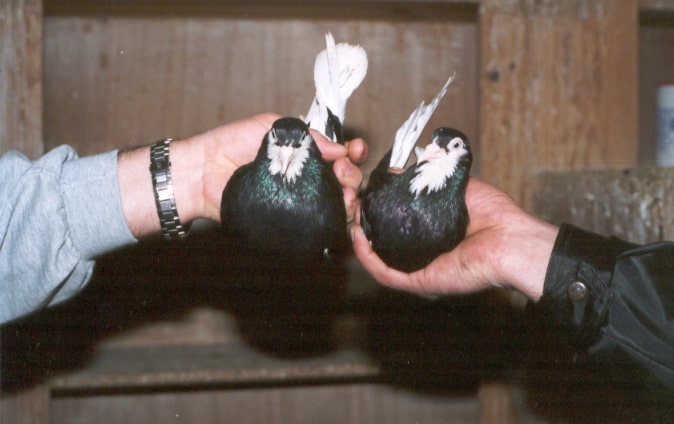
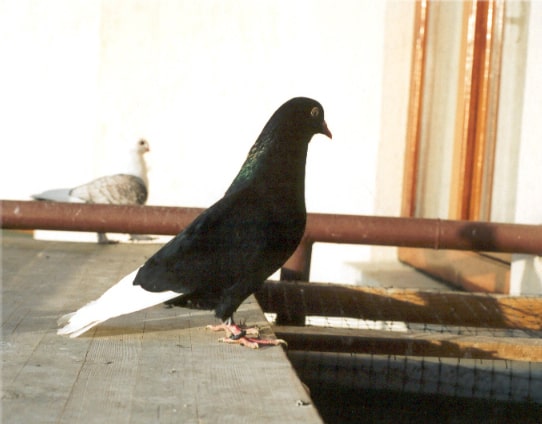
DESIRED QUALITIES IN BURSA
When purchasing a Bursa besides the usual flight and performance qualities there are also physical and color qualities we seek. There are many conflicting opinions between the older generation of fanciers and today's fanciers. There is also different way of looking at these depending on the region of the country. Old fanciers of Bursa state the breed is losing its original qualities and state most of today's birds are mutts. I am going to try to explain the qualities of today's birds I have documented in my research.
Body Shape: Body should be medium sized, standing tall and almost a triangle shape. Wings must be carried above the tail. When looking at the bird from front wide and raised chest must be seen and the body should resemble a narrowing triangle towards the back of the bird. Related to this the waist of the bird should be narrow and the neck should be short. At the same time the legs should not be too long. Bursa's wings, in relation to its body, should be normal size.
Head Shape: Most noticeable feature is the forehead. Starting right above the nose the forehead should present a forward shape. This shape is named "önden beyinli" (forward brain). Head is a smooth round shape and when looked from front resembles the shape of a chestnut. Again, from this angle right at the middle point between the eyes there is a vertical concavity should be seen on the forehead, which makes the forehead look like two separate bumps.
Eyes: Eyes must be very light color. Locally called as "beyaz çakır"(white with blue streaks) or "inci göz" (pearl eye). Completely white color called "yoğurt göz" (yogurt eyes) is the most valuable. In some birds there can be a reddish haze over the eyes. This is called "kızıl çakır" and considered to be a major fault. Eyes must be rather large and close to the beak. The ring of skin around the eyes must be obvious and must be white color. Yellow or red ring cannot be acceptable and the eye lid also must be white in color.
Beak: Beak is very important for this breed. Beak compared to the size of the head and the body must be rather long and thick. Under no circumstances, beak can be thin, and it must be white color. In some Bursas, there can be a small black spot at the tip of the beak called "zikir". This marking is desired in black-winged, white-tailed birds. However, in "yaşmaklı"s and white-winged, white tailed this marking cannot be present.
Color: There are two colors in Bursas. These are black and white. These colors must be pure. White must be bright white and black must be as black as it can get. Mid tones and patches are not present. Black of Bursa is very dark and very shiny black. This color may not be exclusive to Bursa but a rather rare color to be seen in any other breed. Chest of Bursa glow in different tones of green.
Tail lids: Small feathers that cover Bursas tail feathers from top and bottom must draw a very sharp line. They must be losing the tail feathers in a wide bow shape and must be black color. Smaller lid feathers under the tail must be white color.
Legs: Legs must be clean below the ankles. This a clean legged breed and any feather found under the ankle line is considered to be muff and result in the loss of value of the bird. Skin of the legs must be noticeable bright red color. Nails must be white color.Number of tail feathers: Bursa has 12 tail feathers. nothing more and nothing less. Bursa also has an oil gland unlike its relatives Mülakat and Çakal breeds which do not. These breeds carry 14 to 16 tail feathers.
Disorder of White wing: This is not considered to be fault by old fanciers. Black feather seen in some white-wings and the white feather in black wings are thought to not to disrupt the breed qualities. There is also the thought of black feather on the tail or a few small white feathers on the body not being important. However, today's fanciers do not share these opinions. In fact, they consider these to be major faults.
Character and breed qualities: Because of their strict protection by fanciers Bursa has avoided mixing with other breeds and maintained itself as a pure breed. Most important quality desired by fanciers is a pure bloodline in this breed. Secondly, they must not come to a hand, they must behave timid and scared.
Another desired quality of this breed is a newly purchased birds’ behavior in the new coop to be as he has got used to it and accepted it as its new home. Bursas do not show any inclination towards any other coop then their own. Because of this, they are very loyal to their coop. However, when sold to someone else, they will accept the new coop very quickly. They will never go back to their old loft. In fact, most fanciers after bringing in a new bird to the loft, if they don't see the bird getting used to its new surroundings very rapidly, they will be considered to be faulty and give the bird away.
COLOR VARIETIES OF BURSA
Main colors of Bursa are Arap, Beyaz, Karakanat akkuyruk and Akkanat akkuyruk.
Arap: This is a black self bird. They have become rather rare today. White feathers in any part of the body is not acceptable.
Beyaz: This is a white self bird. They are also declining in numbers rapidly. Black feathers in any part of the body is not acceptable. Karakanat akkuyruk: It is also known as karakanat. It is a black bird with only the main tail feathers white color. Any white feather on the wings is not desired and there must not be any black feather on the tail.
Akkanat akkuyruk: In this color, the main tail and flight (wing) feathers are white, and the rest of the birds is black color. It is desired to have the first 7 out of the 10 flight feathers to be white. 7 on each wing is accepted as an ideal marking. It is not desired to have any black feather between the white feathers. This is also the case for tail feathers.In this color there can be various combinations of white markings on the head, below the eyes and below the beak. According to these markings they are given different names.
They are listed below:
Karabaş: These birds have a black head with no white feathers at all. There also should not be any white coloring in any part of the body other than the tail.
Yaşmaklı: Mainly caries the characteristics of Karabaş. However, there is a white marking under the beak that runs down the throat (beard marking). Depending on the length of the white marking they are named separately. The longest marking is named as yaşmaklı.
Muskalı: In these birds the white marking under the beak is not as long as the Yaşmaklı but in the shape of a small triangle.
Noktalı: This is a small marking under the beak in the shape of one or more white dots.
Sürmeli: This is a white marking starting from the eyes and run back towards the ears. Some fanciers call this marking also as çekmeli.
Kilitli: If the white line starting from the eyes do not stop at the ears but run behind the head and connect with the line coming from the other eye, making a straight-line marking
Abraş: Basically, a white stork marking on the forehead.
Akman: Bald head marking like in Döneks.
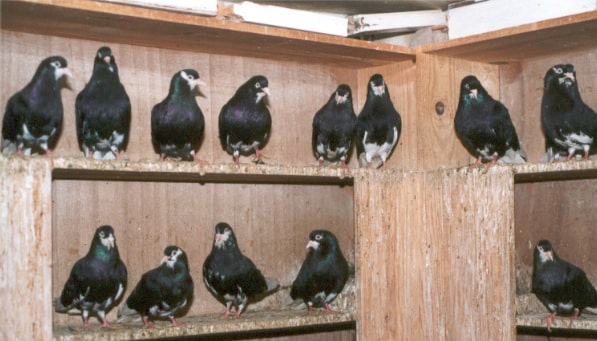
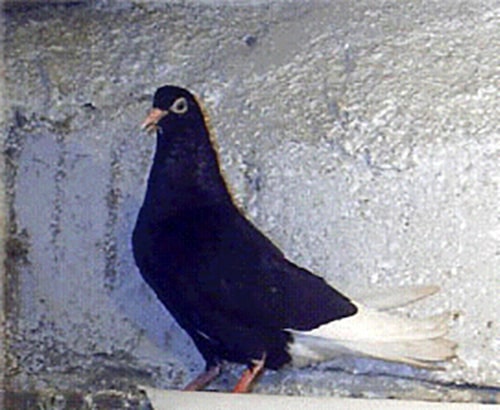
KEEPING AND CARE
Bursas are very loyal to their coop. In this aspect they resemble the racing pigeons. Once used to their coop they will always come to it. For this reason, this is a very trustworthy breed. When released from 50 Km. they will find their home with no difficulty. Lost birds have been observed for 4-5 days looking for their coops. Despite of this they get used to a new coop very quickly.
However, this is not guaranteed. There are bloodlines that will go back to their original coops even after raising their young in another coop. Because of this, it is a good idea to not to fly a newly purchased Bursa for a while. Once they get used to the new loft, they will not create any problems. Young birds get used to their loft very rapidly. In fact, if they are flown once around the loft, they will never leave.
Bursa is a breed that is easy to care for. They can be raised in any region. They are a sturdy and strong bunch of birds. They also raise their young very well. Breeding Bursa because of this presents a large advantage to its fancier over other breeds.
Yavuz İşçen
